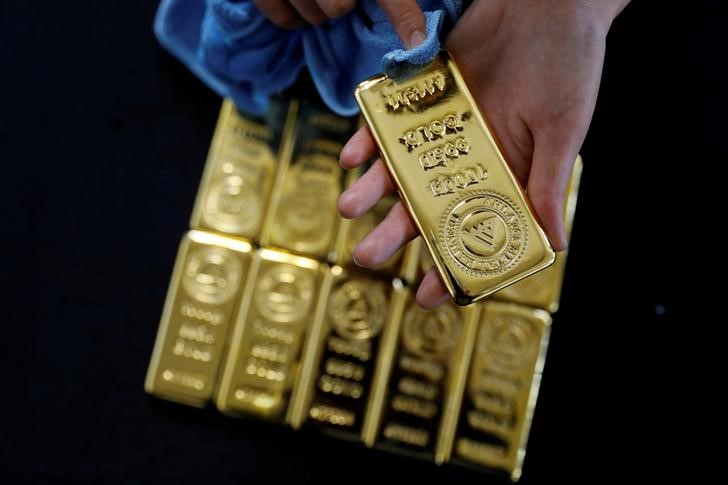Investing.com - A weaker dollar helped propel gold prices to a three-month high back above the $1,300 level on Friday in the final trading day of 2017.
Gold futures for February delivery settled up 0.61% at $1,305.10 on the Comex division of the New York Mercantile Exchange, its highest close since September.
For the year, the precious metal gained 14%, the largest yearly percentage gain since 2010.
Recent weakness in the dollar has supported gold prices by making the dollar-denominated metal cheaper for holders of other currencies.
The dollar fell to its lowest levels in more than three months against a basket of the other major currencies on Friday and posted its largest annual percentage decline since 2003.
The U.S. dollar index, which measures the greenback’s strength against a trade-weighted basket of six major currencies, fell as low as 91.83, the weakest level since September 22. For the year, the index was down 9.8%.
The index started 2017 at a 14-year high, boosted by hopes for U.S. President Donald Trump’s pro-growth economic agenda. But barring a sweeping tax overhaul enacted last week, the Trump administration has struggled to pass legislation.
The dollar also lagged despite the Federal Reserve’s rate increases amid increased investor expectations for other central banks to reduce their stimulus.
Geopolitical risks also remain a focus for gold buyers, as gold is a haven asset that many investors favor when they think markets might turn rocky.
Elsewhere in precious metals trading, silver was at $16.98 a troy ounce late Friday, to end the year with a gain of 6.0%.
Palladium posted the strongest increase among precious metals in 2017, advancing 57% amid concerns over the supply outlook.
Palladium eased 0.78% to settle at $1,055.15 an ounce late Friday after rising to a high of $1,064.20, a level not seen since February 2001 in the previous session
Among base metals, copper ended Friday down 0.41% at $3.295 a pound but added 31% for the year.
Prices of the industrial metal were boosted by robust demand from China, the world’s largest base metals consumer, as well as a favorable global economic outlook and supply disruptions around the world.
In the week ahead, gold prices will remain vulnerable to any rebound in the greenback as well as in increase in yields. The opportunity cost of holding non-interest bearing bullion increases when yields rise elsewhere.
Investors will get back to work when markets reopen on Tuesday after the Christmas and New Year’s holidays, with all eyes on the monthly U.S. employment report due Friday.
Market watchers will also focus on Wednesday’s minutes of the Fed’s December policy meeting for further hints on the future path of monetary policy.
Ahead of the coming week, Investing.com has compiled a list of these and other significant events likely to affect the markets.
Tuesday, January 2
The UK is to release a report on manufacturing activity.
In the U.S, the Institute for Supply Management is to publish its manufacturing index.
Wednesday, January 3
China is to publish its Caixin services index.
The UK is to publish data on construction activity.
The Fed is to publish the minutes of its December meeting, which outline economic conditions and the factors affecting the monetary policy decision.
Thursday, January 4
The UK is to release a report on service sector activity as well as data on net lending.
The U.S. is to release the ADP nonfarm payrolls report and the weekly report on jobless claims. Later in the day, the ISM is to publish its non-manufacturing index.
Friday, January 5
Australia is to release trade data.
The euro zone is to release preliminary inflation data for December.
The U.S. is to round up the week with the nonfarm payrolls report for December as well as data on trade and factory orders.
